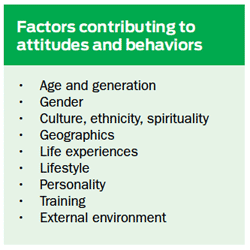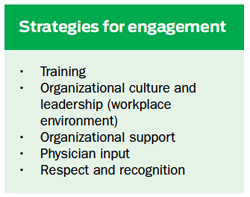Physician engagement: A Multistep Approach to Improving Well-Being and Purpose
By Alan H. Rosenstein, MD, MBA
Have you noticed anything different about Dr. Blott recently? It used to be that when he came to make rounds, he was friendly and willing to help out, but now he seems aloof and barely makes eye contact. When I call him about a patient, he acts like I am bothering him, and he’s very abrupt and insensitive. He seems apathetic and depressed. I wonder what’s going on.
That scenario is not unusual in today’s healthcare world. Changing market dynamics and evolving models of care have shifted incentives, priorities, roles, and responsibilities, severely impacting the attitudes of providers—physicians, nurses, and other members of the healthcare team—and their approaches to medical care. With growing complexities and accountabilities for performance outcomes, physicians need to take a leadership role in directing, managing, and coordinating care delivery across the entire spectrum of care. For this to be successful, we need to better understand physician needs and concerns and develop strategies to enhance physician engagement. This requires a multistep process with the end goal of improving the well-being of physicians and revitalizing their passion and purpose to provide safe, high-value, best-practice care.
Behavioral Influences Engagement is a reflection of values, perceptions, attitudes, ideals, and expectations influenced by life experiences. There are many contributing factors, including age, culture, gender, training, and other family and environmental forces. Each of these can play a significant role in motivating actions and behaviors.
Engagement is a reflection of values, perceptions, attitudes, ideals, and expectations influenced by life experiences. There are many contributing factors, including age, culture, gender, training, and other family and environmental forces. Each of these can play a significant role in motivating actions and behaviors.
Well-known attitude and behavioral preferences have been attributed to age and generation gaps. Veterans and baby boomers have different value systems, goals, and work ethics than Generation Xers, who may clash in a healthcare market saturated with older professionals. It’s not that either group is right or wrong, it’s just that each group needs to be aware of the other’s style and preferences and be willing to work together to achieve a mutual goal.
For physicians, another key contributing factor is years in practice. Physicians who have been in practice for more than 20 years are used to autonomy and control and don’t appreciate what they perceive as outside scrutiny and intrusion regarding their practice and delivery of medical care. Changing insurance contracts, a growing emphasis on performance-based metrics, reduced payments, documentation requirements, and mandatory use of electronic medical records have had a significant impact on practice dynamics to the point where many physicians have either given up private practice or elected to retire early.
Another contributing factor is the influence of culture, ethnicity, spirituality, and geography. Each of these factors can affect views and reactions to power, hierarchy, gender, values, language, and communication styles, which are of particular importance given the growing diversity in both medical staff and patient populations.
These contributing factors, in conjunction with other experiences, lifestyle habits, and current environmental forces, help shape a physician’s ego and underlying personality. As such, they must be considered and addressed by initiatives geared toward influencing motivation, engagement, or behavioral modification.
Physician Engagement
Most physicians just want to practice good medical care, but many of the factors mentioned above can get in the way. In an effort to better engage physicians, a series of steps can be taken to increase the likelihood of a successful outcome (Rosenstein, 2015).
 The first step is education. Keeping physicians up to date about current trends and implications of the changing healthcare environment will help raise their awareness of what is happening and how it might affect their medical practice. The focus is not on the merits of the changes, but on information sharing and ways to adjust and move forward collaboratively to provide best-practice care.
The first step is education. Keeping physicians up to date about current trends and implications of the changing healthcare environment will help raise their awareness of what is happening and how it might affect their medical practice. The focus is not on the merits of the changes, but on information sharing and ways to adjust and move forward collaboratively to provide best-practice care.
The next step is to provide training to help address demographics affecting values, attitudes, and behaviors attributable to age, gender, ethnicity, and personality. Depending on the circumstances, specialized training in diversity management, emotional intelligence, personality traits, conflict management, communication skills, and team collaboration will provide valuable insight and tools that improve staff relationships and engagement.
Organizational culture sets the framework for staff morale and behaviors. Several recent studies have emphasized the importance of organizational culture and leadership on setting workplace tone and its impact on physician satisfaction (Beckman, 2015; Shanafelt et al., 2015).
Sitting on top of organizational culture is the importance of organizational support. Showing physicians the organization cares—making an attempt to better understand their individual needs and concerns, and providing appropriate support to help them adjust to the pressures they face—is probably the most important component for increasing physician engagement.
One of the key contributing factors to disengagement is the growing amount of frustration, anger, stress, and burnout, which is negatively impacting physician satisfaction and behavioral compliance (Shanafelt et al., 2012; Privitera, Rosenstein, Plessow, & LoCastro, 2014; Rosenstein, 2012). The associated physical and emotional turmoil is causing many physicians to become disenchanted with the practice of medicine and pull back, withdraw, retire, or become more apathetic and cynical about practice delivery. More extreme cases can lead to significant behavioral disturbances that negatively impact patient safety and quality of care (Rosenstein, 2013). In this regard, providing appropriate stress management and coping skills is crucial to physician well-being and performance competency (West et al., 2014).
The problem with stress management is physician acknowledgement, acceptance, and willingness to accept help in this area. Many physicians either don’t realize they’re under stress, or if they do, feel it’s a way of life and think they can handle it themselves. Even if they say they’ll cut back on work hours and make time for relaxation, it only takes one patient care call to push this down to a lower priority. Barriers to accepting outside help include perceived need, ego, stoicism, “you don’t understand my world,” and questions or concerns about clinical competency or confidentiality. In this case, the organizations physicians work for or are affiliated with should take a proactive approach to providing assistance and support.
Support can be provided at several different levels. From a logistical perspective, addressing issues related to capacity, productivity, and scheduling will help ease the administrative burden of care. Some organizations have mandated time-off periods from patient care responsibilities. Many organizations are using designated scribes to help ease the burden of documentation. From a clinical perspective, utilizing nurse practitioners or physician assistants can help reduce clinical load and improve capacity. From a behavioral perspective, much can be done to help physicians better adjust to the pressures of today’s healthcare environment.
A simplistic approach is to provide courses on stress management, which rarely afford long-term benefits. Individualized peer support through coaching or counseling is more apt to result in positive outcomes (Shapiro, Whitmore, & Tsen, 2014). Peer support sessions can be conducted through human resources, wellness committees, physician employee assistance programs, or other internal or external specialized programs. The goal of these programs is to work with physicians before an unwanted incident or event occurs and help them thrive and succeed in their medical practice.
Providing back-door programs such as these is vitally important in helping physicians better understand and adjust, but equally important is to open the front door and allow physicians an opportunity to provide input. Offering a way for physicians to openly discuss what’s on their mind is a pivotal piece of engagement. This can be accomplished through a variety of mechanisms. It can start at the entry level, where physicians new to the staff are given a comprehensive onboarding process. That process should not only welcome physicians and help set expectations; it should also begin a conversation about what they perceive are issues of importance. After that, scheduling a process where physicians feel free to exchange ideas should occur on a regular basis. That can happen through town hall meetings, department meetings, special committees or task forces, or one-on-one sessions. The goal is to listen to physician concerns, be responsive, and allow them an opportunity to contribute or participate in program planning.
The final point of engagement is to make an effort to recognize and thank physicians for what they do. The overwhelming rush of day-to-day activities may cause people to forget about the hard work physicians and staff do to make it all happen. Take time to let them know.
Final Thoughts
Physicians and all members of the medical community are a precious resource. They just want to practice good medical care. Helping physicians understand what’s going on around them and why, providing support to help them better adjust to the pressures and stresses of medical practice, and encouraging and responding to physician input will lead to improved behavioral adaptation, increased satisfaction, increased engagement, and restored energy and enthusiasm. ❙
Alan Rosenstein is a practicing internist in San Francisco, and a consultant in healthcare management. Previously he served as medical director for physician wellness services in Minneapolis; medical director of clinical effectiveness and care management at ValleyCare Hospital in Pleasanton, California; vice president and medical director for VHA West Coast; vice president of clinical informatics for McKesson- HBOC; medical director of clinical decision support for HBSI information systems; and director of medical resource management, manager of outcome measurement and chairman of case management at California Pacific Medical Center in San Francisco. Rosenstein has had over 150 publications and extensive national and international lecture and consultation experience in the areas of care management, physician engagement, performance improvement, patient safety, nurse-physician relationships, disruptive behaviors, communication efficiency, physician stress and burnout, and cultural and behavioral factors affecting patient/staff satisfaction and clinical performance. He may be contacted at ahrosensteinmd@aol.com.
References
Beckman, H. (2015). The role of medical culture in the journey to resilience. Academic Medicine, 90(6), 710–712.
Privitera, M., Rosenstein, A., Plessow, F., & LoCastro, T. (2014). Physician burnout and occupational stress: An inconvenient truth with unintended consequences. Journal of Hospital Administration, 4(1), 27–35.
Rosenstein, A. (2012). Physician stress and burnout: What can we do? American College of Physician Executives, 38(6), 22–30.
Rosenstein, A. (2013). Bad medicine: Managing the risks of disruptive behaviors in health care settings. Risk Management, 60(10), 38–42.
Rosenstein, A. (2015, June). Meeting the physician’s needs: The road to organizational-physician engagement. Trustee, 19–22.
Shanafelt, T., Boone, S., Tan, L., Dyrbye, L., Sotile, W., Satele, D., … Oreskovich, M. R. (2012). Burnout and satisfaction with work-life balance among U.S. physicians relative to the general population. Archives of Internal Medicine, 172(18), 1377–1385.
Shanafelt, T., Gorringe, G., Menaker, R., Storz, K. A., Reeves, D., Buskirk, S. J., … Swensen, S. J. (2015). Impact of organizational leadership on physician burnout and satisfaction. Mayo Clinic Proceedings, 90(4), 432–440.
Shapiro, J., Whitmore, A., & Tsen, L. C. (2014). Instituting a culture of professionalism: The establishment of a center for professionalism and peer support. The Joint Commission Journal on Quality and Patient Safety, 40(4), 168–177.
West, C., Dyrbye, L., Rabatin, J., Call, T. G., Davidson, J. H., Multari, A., … Shanafelt, T. D. (2014). Intervention to promote physician well-being, job satisfaction, and professionalism. JAMA Internal Medicine, 174(4), 527–533.
